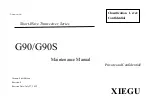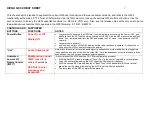
7
UHF Compact Receiver
Rio Rancho, NM – USA
ANTENNA USE AND PLACEMENT
Connect the antenna to the front panel jack. Position the antenna so that it is not within 3 or 4 feet of large metal
surfaces. If this is not possible, try to position the antenna so that it is as far away from the metal surface as is
practical. It is also good to position the receiver so that there is a direct “line of sight” between the transmitter and the
receiver antenna. In situations where the operating range is less than about 50 feet, the antenna positioning is much
less critical.
A wireless transmitter sends a radio signal out in all directions. This signal will often bounce off nearby walls, ceilings,
etc. and a strong reflection can arrive at the receiver antenna along with the direct signal. If the direct and reflected
signals are out of phase with each other a cancellation may occur. The result would be a “drop out.” A drop out
sounds like either audible noise (hiss), or in severe cases, may result in a complete loss of the carrier and the sound.
Moving the transmitter even a few inches may eliminate it. A dropout situation may be either better or worse as the
crowd fills and/or leaves the room, or when the transmitter or receiver is operated in a different location.
Dropouts can be avoided by careful placement of the receiver. If you are mounting the receiver on a video camera or
camcorder, experiment with the location prior to going into the field. By placing the antenna above the body of the
camera, you will increase your operating range. If the antenna is laid next to the camera, as shown in the illustration
below, the body of the camera will serve as a shield and reduce range. This position may work but be certain at least
part of the antenna extends above the camera. Alternate locations can include the back of the camera, the top of the
camera or mounted vertically on the side.
If dropouts occur in the field, moving the transmitter or receiver slightly in any direction will usually eliminate the
problem.
EXAMPLE MOUNTING LOCATIONS
FOR SINGLE OR MULTIPLE
RECEIVER(S)






























